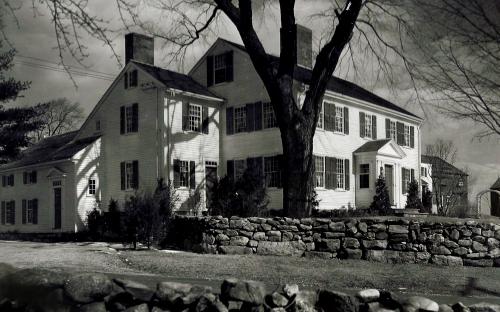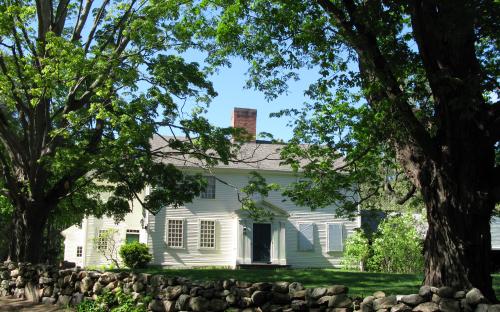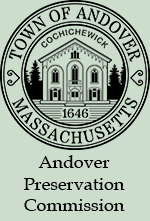Architectural Description:
NRIND NRMRA
Style: Georgian-Federal
Other features: ell may be earlier ?; chimney looks older; brick floor in basement; good site
Historical Narrative:
Present owner: Taft, Frederic Emil (14 Jul 1967)
Original owner: David Gray II built house; (land in Gray family from 1699)
Subsequent uses: Blacksmith shop from 1737; Grist Mill, a Mill for grinding scythes; granary; spinning shop on property; weave/spin shop
Themes: Agricultural, Architectural, Community development
Historical significance: In 1679, Nicholas Holt, (one of original Andover freeholders) specified "for the love he bears his son-in-law, Robert Gray" made him a gift of 5 acres, south of Holt's Hill. Gray Farm dates from 1699, when Robert Gray, Mariner, bought land from Nicholas Holt and Dudley Bradstreet. According to old deeds, Gray land holdings were extensive, include Gibbet plain, present Harold Parker State Forest, where was once located the place for public execution for Essex and Middlesex County.
David Gray b. Oct. 12, 1717, son of Robert & Miriam (Lovejoy) Gray married on June 3, 1756, to Rebekah Holt bpt. Oct. 31, 1725, dau. of Samuel & Jemima Holt. They had three children: Sarah b. May 9, 1759, David 2nd b. Dec. 8, 1762, and Cornelius b. Oct. 29, 1765. David Sr. died on Jan. 7, 1767, of “suicide and was buried at the cross-roads”. David hanged himself and was refused Christian burial at South Church Cemetery. Their mother Rebekah (Holt) died in July 1800 at age 75y 10m. Alice Gray later had him reburied in the family lot in the South Cemetery.
David Gary 2nd married Sarah Cummings on April 3, 1788. They had one daughter Mary Eastman Gray bpt. April 1, 1791, and she married 1814 to William Eaton of Reading. Sarah b. 1763 died on Mar. 15, 1793, of consumption at age 25. David remarried on Feb. 23, 1797, to Rebekah Jenkins b. Nov. 7, 1735, dau. of Samuel Jr. & Anna (Upton) Jenkins. This union produced four children: David b. Mar. 15, 1798, Rebekah bpt. Mar. 24, 1799 – d. 1802, Samuel b. Jan. 30, 1803, and Henry Jenkins Gray b. Dec. 17, 1806. David II was excommunicated from South Church as a Universalist in 1830.The farm remained with Widow Rebekah and their children. Son Cornelius died on Oct. 12, 1782, age 17. In 1786 Sarah Gray sold her share of the farm to her brother David.
David Gray built the current house on the property in 1812, had lumber hauled by oxen from his wood lot in Wilton, N.H. Remains of earlier buildings are still extant. Farm was once self-sufficient and included on grounds, a granary, cider mill, blacksmith shop, spinning house, grist mill on Skug River and a mill for grinding scythes. David continued to work the farm until his death at age 81 on March 7, 1844, of Lung fever. Rebekah (Jenkins) died on April 9, 1840 age 67. Son Henry Jenkins Gray inherited the homestead through his father’s will and worked the farm. It has been said that Henry built the blacksmith shop.
The 1850 Andover Valuation on the Gray farm of 275 acres = $13,630. Personal Estate, Farm Stock $467 and money $5000. Dwelling house $1200, Barn $400, Other blds. $120 , Granary $75, house lots 29 acres $1305, 11a Ox Pasture $275, 13a Cummings pasture $247, 7½a Ballard pasture, 4a lower pasture $100, 13a Bald Hill $200, 19a Blunt Swamp, 1a Turf land $25, 21 Jenkins pasture 21a ½a Wood lot $2725, 13a Pine Hill $600, 21a Hayward & Tucker Lot $525, 6a Farnham Wood lot $180, 4a Chickering Lot, 16a Flagg Piece $410, 40 acre South of road $1370 and the Pierce House (#57 Main St.).
The 1850 Census in August lists just Henry J. 44, Mrs. Carlton 20, and David Gilchrest age 14. The 1860 Census: Henry 53, wife Lydia L. 42, Henry 8, Alice 6, Lydia A. Sawyer 18 & Sarah L. 15 and Michael Noland 24 of Canada.
Henry Jenkins Gray b. 1806 married on May 14, 1851, to widow Lydia Sawyer of Rindge, N.H. daughter of Francis & Lydia (Hibbert) Sawyer. Lydia had two children by her first marriage: Lydia Augusta Sawyer b. 9/16/1840 and Sarah Lavinia Sayer b. 10/7/1843. Both were raised in the Gray homestead. Henry & Lydia had two children: Henry Jenkins Gray b. July 6, 1852, and Alice Gray b. Aug. 28, 1854. Henry Sr. died July 6, 1881. Lydia died on Aug. 12, 1887, age 74.
Charlotte Helen Abbott wrote: “Henry Gray, brother of David, was a fine farmer. The old house stood in the yard of the house that David once lived in, probably Nicholas Holt. Henry was a very systematic farmer, orderly, of good taste. He was a scientific farmer also, could turn his hand to anything, made shoes, ox sleds, wagons, was a blacksmith and also had a sawmill. He was a well read and generous, a regular Holt in type.”
Henry J. and his sister Alice continued to live in the Homestead with stepsister Sarah L. Sawyer. Lydia A. Sawyer married Arron Cummings and lived on 28 Phillips St. Sarah owned the Holt house 89 Prospect Hill from 1888-1902.
Henry J. Gray died Sept. 22, 1909, - AT Sept. 26, 1909 - HENRY GRAY Henry Gray of the Holt district died at the old Gray homestead on Wednesday after a long illness. Deceased was 57 years old and had been a farmer all of his life. He was of a quiet and reserved nature but was highly esteemed by those who knew him. He is survived by a sister. Miss Alice Gray. Funeral services are being held this afternoon.
Alice Gray remained at the farm until her death on May 7, 1924. Stepsister Sarah L. Sawyer and niece Lois Cummings where heirs to the property. Sarah died on March 3, 1927, and Lois M. Cummings, two months later on May 24, 1927. Lois's siblings Florence L. Cummings & Arthur G. Cummings were the remaining family heirs, children of Lydia A (Sawyer) Cummings.
The Gray family homestead was sold on January 19, 1932 ending over 230 years of ownership by the family.
Amy Gordon Taft, wife of Rev. Arthur N. Taft purchased the Gray farm. Arthur Nelson Taft was born Aug. 23, 1867 in Orangetown, Rockland Co. NY, son of Enos N. & Julia Taft. Arthur graduated from Williams College in 1890, Andover Theological Seminary & Episcopal Theological School in Cambridge. He was Rector of St. Stephen’s Church in Colorado Springs from 1900 – 1937. Arthur married in 1901 to Amy Gordon Torrance b. Dec. 27, 1873 Palisades, NJ, dau. of Henry & Sarah C. (Peet) Torrance. They had four children all born in Colorado Springs, CO: Alexander Torrance b. Nov. 30, 1903, Frederick Peet b. July 25, 1904, Barbara Nov. 11, 1908- d. May 22m 1911 and Rebecca Lockwood b. March 3, 1912.
Rev. Arthur Taft restored house after 1932; took out one stairway leaving two; removed Victorian era porch which had been added by Alice Gray; reduced bedrooms to four to put in two more bathrooms. Door latches in house were most likely made at the blacksmith shop on premises. Amy Taft died on Oct. 3, 1962-64? Arthur died on Feb. 27, 1967 age 99.
The property was inherited by their children, each with 1/3 share of the property. Alexander and Rebecca sold their shares to Frederick on June 6, 1967.
Fred Peet Taft was also a Episcopalian minister, a graduate of Harvard University and the Episcopal Theological School in Cambridge, Ordained in 1930, also held a Master’s Degree in Education from Harvard. Fred married on Dec. 30, 1940 to Emily Walton of Tenafly, NJ. Emily was b. May 6, 1906 in Belmont, MA, dau. of Perry * Mabel A. (Kingman) Walton. Fred was rector of several parishes and assistant at St. Paul’s, Rochester, N.Y. 1950 until his retirement in 1967. After World War II, he organized the Overseas Relief Center of Rhode Island Council of Churches. Fred was member of the Andover Historical Commission 1982-1983. Fred died on Feb. 7, 1983 in Lawrence. He is survived by his wife, Emily (Walton) Taft; a brother, Alexander Taft of Louisville, Ky.; a sister, Rebekah Taft of Colorado Springs.
Emily Walton Taft continued ownership and preservation of the Gray homestead. Some parcels of land were sold off as house lots through the years. A large adjoining parcel of 15 acres was gifted to the Trustees of Reservations and is now included in the Charles Ward Reservation. Emily also placed a Preservation Restriction on the house and barn on the property. Emily died on May 24, 1997. Emily and Fred are interred in the Walton family lot at Evergreen Cemetery, East Harwich, MA.
The property was inherited by their nephew and nieces: Frederick L. Taft, Natalie T. Andrews, Eleanor T. Etheridge. The Taft family have been wonderful stewards of the property for 93 years as of 2025.
Outbuildings:
The Blacksmith shop across street from house at 237 Salem St. is mentioned in Gray will dated 1737; although constructed of wood, it is in good condition and still contains some early blacksmith tools. Foundation opposite house is "Old Gray Mill" or grist mill "the old grindstone is down in field with top stone, Miss Alice Gray used to cap her own well" (note: Andover Historical Society files) dated May1934.
The small house also at 237 Salem St. was moved and is thought to have been ell of original house (1699). Alice Gray sold this part of 1699 house and it was moved across street as spinning house, with spinning wheels, reels, etc. Altered when moved. Miss Gray also sold some window sashes with leaded glass to be used in Henry Ford's Dearborn, Michigan museum. Door of spinning house thought to be the door of the first Gray house here.
These two building were dismantled in the 1990s and gifted to the Andover Historical Society. After nearly a decade in storage, they were given back to the Taft family and reconstructed on the Homestead lot at 232 Salem St. Replica building now occupy the property at 237 Salem St.
Rev. Arthur Taft restored house after 1932; took out one stairway leaving two; removed Victorian era porch which had been added by Alice Gray; reduced bedrooms to four to put in two more bathrooms. Door latches in house were most likely made at the blacksmith shop on premises.
Bibliography/References:
Andover Historical Society files
North Andover Historical Society file: Merrimack Valley Textile Museum
Abbott, Charlotte, Helen; "Andover Families - Gray"
Goldsmith, Bessie; "Historical Houses of Andover, Mass." 1946
Taft, Rev. Arthur; "The Gray Farm and its Family" delivered before Andover Historical Society, Jan. 25, 1942.
See also Barn Survey
May 1991, Andover Preservation Award
See 1980 National Register Nomination for updated information
Plan #12623 Lot A –
Plan #5691 – May 5, 1967 – Blacksmith 7 Weaving shop lot 1.29 acres
Ownership :
Nicholas Holt, wife Elizabeth (Short)
Robert Gray, wife Hannah Holt (dau. of Nicholas) m. 1668-9 Salem, MA
Robert Gray 2nd, wife Miriam (Lovejoy) – m. 1705
David Gray, wife Rebekah (Holt) m. 1756
David Gray 2nd, wife Sarah (Cummings) m. 1788 & Rebecca (Jenkins) m. 1797
David Gray estate died March 7, 1844 heir Henry J.
Henry Jenkins Gray, wife Rebecca – Jan. 9, 1837 rec. 9/19/1837 – b. 302 leaf 157
Henry J. Gray – Apr. 21 1840 – b. 331 leaf 130 discharge load
Henry Jenkins Gray, wife Lydia (Sawyer) – m. 1851
Henry Jenkins Gray estate – died July 6, 1881
Gray Heirs; Henry Jenkins Gray Jr. Oct. 13, 1881 b. 65 p. 426 96 acres
Alice Gray - July 30, 1901 – b. 187 p.411 from Bethena Ford
Henry Jenkins Gray estate – died Sept. 22, 1909
Heirs Alice Gray, Lydia L. Sawyer, Sarah L. Sawyer
Alice Gray – April 7, 1910 – b. 287 p. 40 from Lydia Cummings
Alice Gray – April 7, 1910 – b. 287 p. 42 from Sarah L. Sawyer
Alice Gray Estate died – May 7, 1924
Sarah L. Sawyer & Lois M. Cummings Heirs
Sarah L. Sawyer estate – died March 3, 1927
Lois M. Cummings – died May 24, 1927
Florence L. Cummings & Arthur G. Cummings heirs
Amy Gordon Taft Jan. 19, 1932 – b. 562 p. 593
Amy Gordon Taft Estate – Probate 273512
Heirs: Fred P., Alexander T., Rebecca L. Taft – June 6, 1967 – b. 1085 p. 228 1/3 each
Alexander T. Taft & Rebecca L. Taft – June 6, 1967 – b. 1085 p. 228 – Fred’s 1/3
Fred P. Taft – June 6, 1967 – b. 1085 p. 228-229
Fred P. & Emily Walton Taft – July 12, 1967 – b. 1086 p. 123
Fred P. Taft estate – died Feb. 7, 1983 – Probate #359438
Emily Walton Taft – Feb. 7, 1983
Emily Walton Taft estate, Fred L. Taft & State St. Bank, Extrs. - Feb. 23, 1999 – Probate #97P1674-EP1
Taft Heirs: Frederick L. Taft, Natalie T. Andrews, Eleanor T. Etheridge - Mar. 11, 1999 – b. 5367 p. 291
Natalie T. Andrews, Eleanor T. Etheridge – Feb. 16, 2006 – b. 10130 p. 259
Frederick L. Taft, Natalie T. Andrews, Eleanor T. Etheridge – Sept. 5, 2014 – b. 13971 p.39
Trustees of Eleanor Taft Etheridge – Aug. 25, 2014 –
Eleanor T. Etheridge, William D. Etheridge Jr., Mark A. Etheridge
Natalie T Andrews Revocable Trust – Aug. 16, 2023 – b. 17810 p. 343
Frederick Lockwood Taft, Trustee -2023
Other deeds;
Emily Walton Taft gifted Lot B on Plan #12623 of 14.47 acres east of the homestead lot it to the Trustees of Reservations - June 30, 1995. - Book 4287 p. 87
Plan #12623 Lot B shows the lot as 14.47 acres. Trustee of Reservations has it at 15.47 acres. This parcel is now recorded as 2 Gray Road.
Use code 950 Vacant, Conservation, Charitable Organization. Wet lands 1998, 15ft. no cut zone. Single Residence C. - Open Space - Charles W. Ward Reservation.
Owners; Trustees of Reservations - 572 Essex St., Beverly, MA 01915
237 Salem Street – Plan #13235 - former location of the Weaver’s cottage & Blacksmith shop now occupied by replicas of the originals in the 1990s.
Fred Lockwood Taft to Robert W. Sinnott – June 20, 2025 – b. 18310 p. 270
Inventory Data:
| Street | Salem St |
| Place | Holt District |
| Historic District | Individual National Register Listing |
| Historic Name | Gray, David House |
| Present Use | residence |
| Original Use | farm and residence |
| Construction Date | 1812 |
| Source | early records - style - njs |
| Architectural Style | Georgian |
| Wall/Trim | clapboards |
| Outbuildings / Secondary Structures | large barn to rear |
| Major Alterations | restored (1932) ell moved from original house across street (mid - 19th century) |
| Acreage | 3.58 acres; lot size: 27.49 acres??; approx. frontage: 1770' |
| Map and parcel | 27-7 |
| Recorded by | Stack/Mofford |
| Organization | Andover Historical Commission |
| Date entered | 1975 - 1977 |









